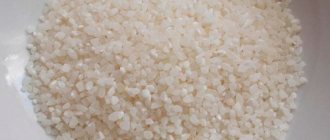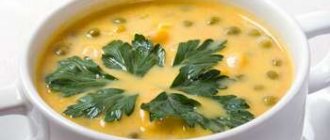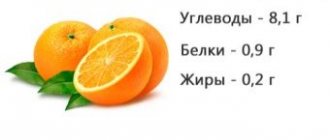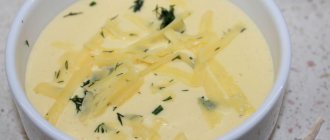What is millet
Content:
- What is millet
- Where did it come from?
- The nutritional value
- Beneficial features
- Hazardous properties
- How to choose and store correctly
- How to cook millet
- Millet: a universal medicine
Millet is the seeds of millet, a cereal plant common in our latitudes. These golden grains are used to prepare various dishes, and the consistency of the finished millet can vary from the form of an airy puree to a crumbly porridge reminiscent of rice.
And since this porridge is completely gluten-free, it is suitable for people hypersensitive to gluten.
Millet grains are round and tiny in size. Their color can be of different shades. The most common form is the hulled grain used to make couscous.
Summarize
- Millet is a grain derived from cultivated millet species that contains protein, antioxidants and nutrients.
- It may have various beneficial properties, such as helping to lower blood sugar and cholesterol levels. It's also gluten-free, making it a great choice for people with celiac disease or on a gluten-free diet.
- Its nutty flavor and versatility make it worth a try.
Millet
Where did it come from?
Researchers suggest that millet originated in North Africa, in the Ethiopian region, 10 thousand years ago. There are mentions of this cereal in the Bible and in ancient Russian chronicles. Our ancestors revered it on a par with wheat. Millet porridge has been known since ancient times in India, Greece, Africa and Asia; in the Middle Ages, before potatoes and corn became popular, millet was a staple product, especially in Eastern European countries. There are many varieties of this cereal, but the most popular is Pennisetum glaucum. Today, the main suppliers of millet are India, China, and Nigeria. This crop has gained its popularity due to its high yield, which remains high even under unfavorable weather conditions.
The benefits of millet for the heart and liver
Millet is the best product for the cardiovascular system. Firstly, it contains vitamins necessary to strengthen the heart muscle and increase the elasticity of blood vessels. Secondly, millet lowers cholesterol levels by destroying cholesterol plaques and thus serves as a preventive measure for atherosclerosis. Thirdly, porridge normalizes heart rate and improves blood circulation, so all those who suffer or are susceptible to cardiovascular diseases simply need to eat millet at least periodically.
High-quality cleansing is another invaluable benefit of millet for the body. There is a version that it not only removes waste and toxins, cleanses the intestines, but also binds harmful ions of heavy metals. This is especially necessary for those who live in an area with poor ecology or are treated with antibiotics - the liver will thank you very much for consuming millet. And you will feel much better.
The nutritional value
The high content of nutrients allows millet to be included in the list of the most healthy products. A serving of this porridge will provide the body with rich doses of B vitamins, calcium, iron, potassium, zinc, magnesium, as well as essential fatty acids. In addition, millet is a source of proteins and fiber necessary for proper digestion.
A serving of millet porridge is:
- 286 kilocalories;
- 8 g proteins;
- 57 g carbohydrates;
- 2.4 g fat;
- 5 mg sodium;
- 106 mg magnesium;
- 2.2 mg zinc;
- 0.3 mg thiamine;
- 3.2 mg niacin;
- 1.2 mg polyunsaturated fat;
- 3.1 g fiber.
Calorie content and chemical composition of millet, vitamins
Millet has a high energy value - up to 342 kcal per 100 g of product. It contains 11.5 g of protein, 66.5 g of carbohydrates and 3.3 g of fat.
The cereal contains nutritional components:
- 9% vegetable fiber;
- essential amino acids - leucine, aspartic acid, threonine;
- vegetable proteins prolamins and glutelins;
- minerals - magnesium, copper, fluorine, iron and manganese;
- 2% sugars;
- vitamin group B - thiamine, riboflavin, pantothenic and nicotinic acids.
Does it contain gluten
Millet does not contain gluten, a storage protein found in some cereals. Therefore, cereals can be easily consumed by people with individual intolerance to this compound and following a gluten-free diet.
Does it contain starch?
Cereals contain about 66.5% carbohydrates, most of which are starch. Only 2% comes from easily digestible structures. Starch consists of amylose and amylopectin, which are partially broken down by saliva and hydrochloric acid in the stomach.
Reference. Due to the high starch content, millet increases in size during cooking, absorbing liquid. Due to this effect, when it enters the stomach, the swollen cereal presses on the walls of the organ, causing a feeling of fullness.
Beneficial features
Millet is more than an alternative to other more common cereals. This product is one of the best sources of copper, manganese, phosphorus and magnesium.
Heart protection
Being a good source of magnesium, millet is a beneficial food for maintaining heart health. This mineral is known to stabilize blood pressure and reduce the risk of heart attack, especially in people with atherosclerosis or diabetes. In addition, millet supplies the body with potassium, a substance that has vasodilating properties and can lower blood pressure. Lignins contained in millet seeds also have a beneficial effect on the cardiovascular system.
Cholesterol control
Heart health directly depends on the level of cholesterol in the blood. Products such as millet (rich in fiber) are excellent at cleansing the body of “bad” cholesterol and increasing the level of “good” cholesterol.
Source of “building materials” for the body
Phosphorus, one of the components of millet, is an important element for the formation and maintenance of the structure of all cells in the body. In addition, this mineral takes part in the formation of the mineral matrix of bones. Phosphorus is an essential element of other vital compounds, including the ATP molecule, which is responsible for the energy “feeding” of cells. Being a component of nucleic acids, it is included in the list of “building materials” for DNA. Among other things, millet porridge, as a source of phosphorus, is necessary to maintain the integrity of the cells of the nervous system.
Benefits for diabetes
Millet seeds supply the body with magnesium. This mineral is important because it promotes the production of more than 300 enzymes, including insulin. Modern studies have shown that regular consumption of millet reduces the risk of type 2 diabetes by almost 30%. Scientists made these conclusions based on the results of 8 years of experience with the participation of 41 thousand people.
Benefits for the gallbladder
Eating foods high in insoluble fiber (and millet is exactly that) prevents the formation of gallstones in women. This statement was made by American scientists who observed 7 thousand participants in the experiment for 16 years. Observational results showed that those women who regularly included these foods in their diet were 17% less likely to develop gallstones.
Researchers have studied this phenomenon and announced interesting findings. It turns out that insoluble fiber not only shortens the time food stays in the intestines, but also reduces the secretion of bile acids, and it is their excess that causes the formation of stones. In addition, scientists have learned that foods such as millet increase insulin sensitivity and reduce the concentration of triglycerides in the blood.
Benefits for digestion
Since millet seeds belong to the group of foods rich in fiber, they also have a beneficial effect on the functioning of the digestive system. So you don’t have to worry about the possible occurrence of constipation, flatulence or abdominal cramps if you have a sufficient amount of millet in your diet. In addition, millet porridge can protect against serious diseases of the gastrointestinal tract, in particular, prevent stomach ulcers or colon cancer. Regular consumption of this cereal also improves the functioning of the kidneys, liver, and immune system (directly depends on the functioning of the digestive system).

Cancer protection
When scientists from the UK summed up the results of a study in which almost 36 thousand women took part, they found that a diet rich in millet prevents breast cancer during the perimenopausal period. The risk of developing the disease in the study participants decreased by almost 41 percent, provided that the diet contained at least 30 grams of fiber.
Preventing asthma
Scientists believe that the fiber contained in whole grains has the ability to protect the body from asthma. At least, this assumption has already been proven several times by the results of scientific experiments conducted by the Americans and the Dutch. The most encouraging results were obtained from experiments with the participation of children. American researchers say that consuming whole grains such as millet, as well as fish, reduces the risk of asthma in childhood by 50 percent. The results of the Dutch experiments are also encouraging. In addition, the Dutch believe that fiber from millet and vegetables helps reduce wheezing in children with asthma by 20%.
In addition, both groups of scientists agreed: fiber from whole grains is equally beneficial. But compared to wheat, which is an allergen for many, millet is a safer product.
Detoxification
Antioxidants found in millet help neutralize free radicals that can cause cancer. In addition, millet cleanses the body of most toxins, particularly from the kidneys and liver.
Other benefits for the body:
- Millet is an alkaline product that is easy to digest.
- The inhabitants of the foothills of the Himalayas, known for their exceptional longevity, rely on millet seeds as their staple diet.
- In the body, this porridge works as a prebiotic (feeds beneficial microflora).
- The serotonin contained in this product improves mood and calms the nervous system.
- Thanks to the magnesium in its composition, millet can relieve migraines.
- The high protein content makes this product useful for vegetarians, and the absence of gluten makes it useful for allergy sufferers.
- Promotes effective weight loss, therefore it is a component of many weight loss diets.
Harm and contraindications
Despite its many beneficial properties, if used incorrectly, millet can cause harm to the body.
Abuse of the product leads to digestive problems:
- increased gas formation in the intestines;
- pain in the epigastric region;
- heaviness in the stomach;
- constipation
The negative effect is due to the high content of coarse fiber in millet. Dietary fiber is practically not digested in the stomach, absorbs excess liquid and swells. As a result, the passage of semi-digested food and feces through the intestines slows down, and smooth muscle peristalsis increases.
Attention! Due to its high carbohydrate content, consuming large amounts of millet can lead to excess weight. This is a high-calorie product: cereals are not recommended for people with obesity.
Millet is contraindicated in the following cases:
- diseases of the gastrointestinal tract - gastritis, ulcerative lesions, gastroenteritis, increased acidity of gastric juice, frequent heartburn, stool disorders;
- individual intolerance to the product;
- thyroid diseases;
- period of treatment with antibacterial drugs - millet accelerates the elimination of active substances, reducing the therapeutic effect of medications.
It is not recommended to consume millet cereals together with products containing iodine. Cereals interfere with the absorption of this element in the intestines.
How to choose and store correctly
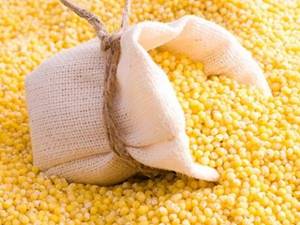
Millet seeds as a food product are available as hulled whole grains. It is supplied for sale by weight and packaged. When choosing a product, it is important to pay attention to its color, aroma (if there is a rotten smell) and check the integrity of the packaging (if we are talking about hermetically sealed ones). You can store cereals for several months (preferably in a dark, dry and cool place).
From what grain is millet obtained?
Millet is the seed of millet, so it is a mistake to assume that they are different plants.
There are about 400 varieties of millet and it is grown on a large scale to produce millet groats.
There are 3 types of grains:
- millet-dranets are whole grains freed from the flower film;
- crushed cereal is a by-product of the food industry;
- polished millet - grain kernels freed from the outer shell, due to which they cook faster and are much easier to absorb by the body.
How to cook millet
Like all porridges, millet must be rinsed under running water before cooking and any debris (if any) removed. Then pour 1 part millet into 2.5 parts boiling water, milk or broth. Bring to a boil, reduce heat, cover and simmer for about 25 minutes. In this way you can prepare crumbly porridge. In order to get a creamy consistency, you will need a little more liquid, and during the cooking process you will have to stir the porridge often.
What can be prepared from millet:
- Milk millet porridge is an excellent option for breakfast;
- raw millet grains are added when baking bread and buns;
- add to soups;
- if boiled millet is mixed with chopped vegetables, chicken and cheese, and then put in the oven for a few minutes, you will get an appetizing casserole;
- can be used as a side dish, as an alternative to potatoes or rice;
- in some regions it is used as an ingredient for stuffing cabbage rolls.
The effect of millet on the body
Millet porridge prevents the formation of cholesterol plaques and fat deposits. Millet is a necessary element of the diet of residents of large cities and areas with poor ecology. The components that make up millet remove toxic compounds, toxins and even heavy metal ions from the body. Recently, information has begun to appear that millet is capable of removing antibiotics from the body. Despite the fact that this fact has not yet received scientific confirmation, it would be a good idea for anyone who has taken antibiotics to include millet porridge in their menu.
Millet is an indispensable food for people suffering from diseases of the digestive tract (pancreatitis), liver diseases, diabetes, atherosclerosis, and allergies.
Millet: a universal medicine
However, millet can be not only an ingredient in delicious dishes and an effective preventive measure that maintains health. This porridge has truly miraculous abilities - it can cure many ailments.
Cystitis
An infusion of millet will help get rid of this unpleasant disease (pour the cereal with water, mix, strain). Take the infusion (it should be cloudy white) 4 times a day, half a glass. Acute symptoms will disappear on the second day, the disease will completely disappear after 2 weeks of treatment.
Angina
Add a little soda (about 1 tsp) to half a glass of warm millet porridge. Place the pulp as a compress on the throat and wrap it up. Keep for several hours. Usually 3 procedures are enough for recovery.
Diarrhea
Grind the millet in a coffee grinder. Take a teaspoon without drinking. Signs of improvement are noticeable after the first intake of millet powder.
Gout
Grind half a glass of millet in a coffee grinder and mix it with 1 tablespoon of wet yeast and 1 tsp. salt. Apply compresses from the resulting mixture overnight.
Heartburn
Eat millet porridge three times a week. To prepare it, rinse the cereal and bring to a boil, drain the liquid and add clean water. Porridge prepared in this way is also useful for diseases of the pancreas.
Angina pectoris
Fry approximately 60 g of millet in a hot frying pan (the color should remain yellow). Add 150 ml of water and cook until the liquid has completely boiled away. Take equal parts 4 times a day. The course of treatment is 2 months.

